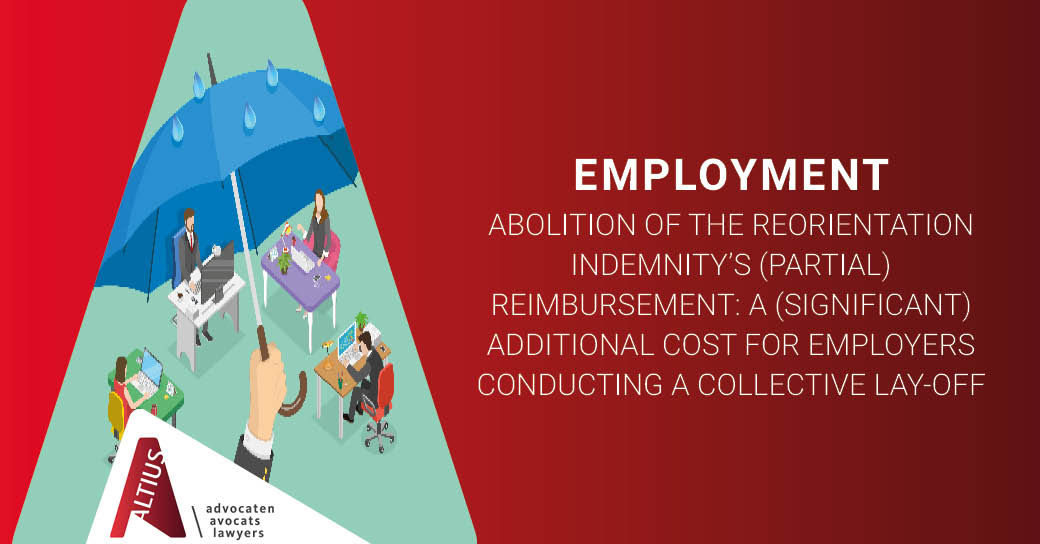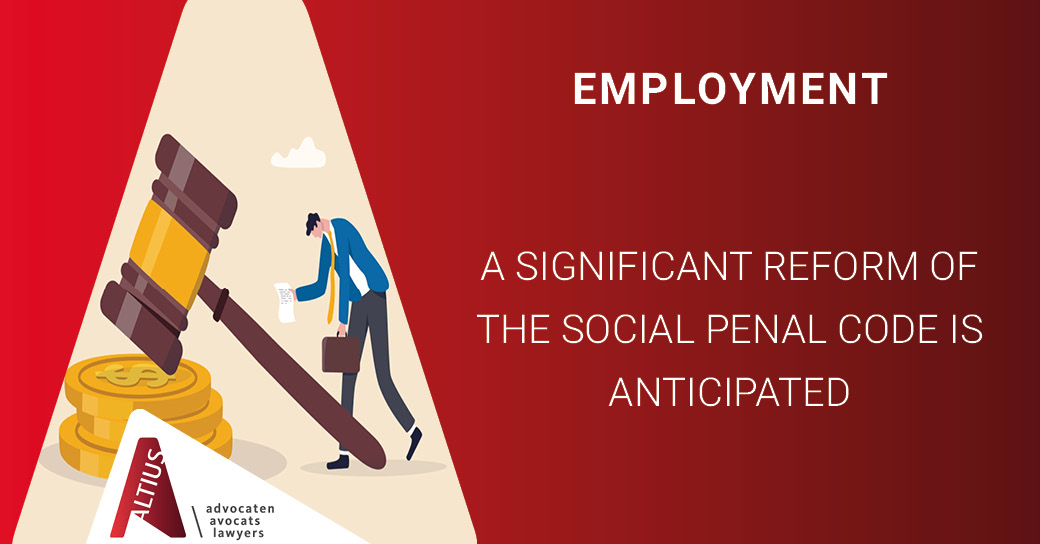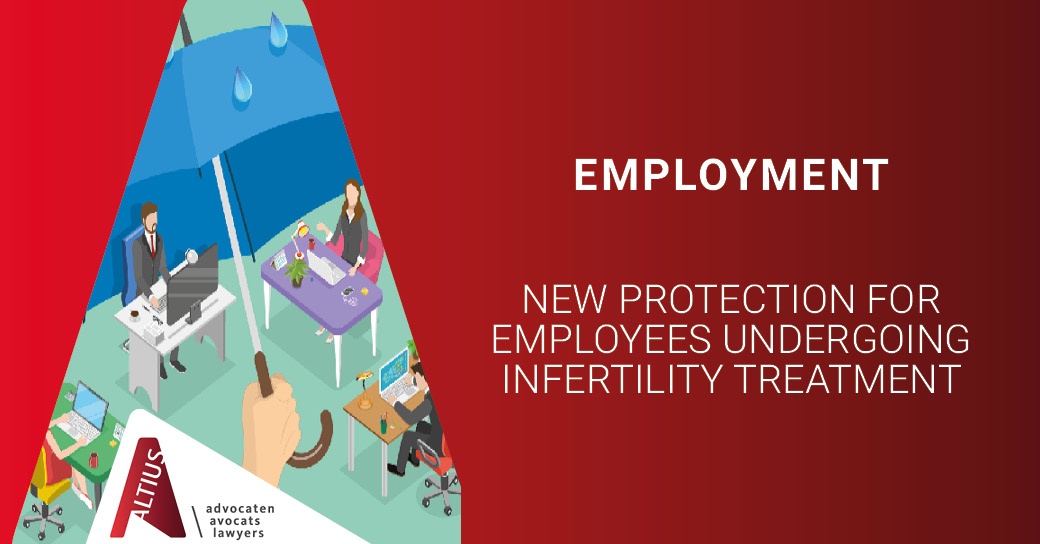Abolition of the reorientation indemnity’s (partial) reimbursement: a (significant) additional cost for employers conducting a collective lay-off

Employees terminated in the frame of a collective lay-off may participate in a redeployment cell, which helps them to find new employment. Any participating employee is entitled to a monthly reorientation indemnity equal to his/her salary inclusive benefits during a period of 3 or 6 months. The employer pays the reorientation indemnity. Until very recently, an employer could obtain a reimbursement from the unemployment office (“RVA”/“Onem”) for the amount of the reorientation indemnity exceeding the statutory indemnity in lieu of notice.
This reimbursement scheme has recently been abolished. Employers now have to bear the full cost of the reorientation indemnity, even if it exceeds the statutory indemnity in lieu of notice cost. This is one of the budget measures that the government decided upon last year, and it could result in a (significant) increase in employers’ restructuring costs.
1. What is a reorientation indemnity?
Employers conducting a collective lay-off are required either to establish a redeployment cell [1] or to affiliate with an existing redeployment cell.
Affected employees with a length of service of at least 1 year at the time of the collective lay-off’s announcement date are entitled to a reorientation indemnity if they participate in the redeployment cell.
The reorientation indemnity varies according to an employee’s age at the collective lay-off’s announcement date:
- Employees aged < 45 are entitled to a reorientation indemnity equal to 3 months’ salary;
- Employees aged ≥ 45 are entitled to a reorientation indemnity equal to 6 months’ salary.
The reorientation indemnity is paid out to employees on a monthly basis and it fully or partially replaces the statutory indemnity in lieu of notice. If the statutory indemnity in lieu of notice exceeds the reorientation indemnity, then the employee will receive the balance of the statutory indemnity in lieu of notice.
Example: An employee is aged 50 at the date of the collective lay-off announcement. On the basis of his length of service, the employee is entitled to a statutory indemnity in lieu of notice equal to 10 months and 30 weeks of salary. The employee participates in the redeployment cell. The employee will receive a monthly reorientation indemnity for a period of 6 months from the employer. Afterwards, the employee will receive the balance of the indemnity in lieu of notice for the amount of 4 months and 30 weeks’ salary.
2. Looking back: (partial) reimbursement of the reorientation indemnity by the unemployment office
Depending upon an employee’s age and length of service, it is possible that an employer is required to pay a reorientation indemnity of which the cost is higher than the statutory indemnity in lieu of notice.
In such a scenario, the employer has had, until recently, the right to claim a reimbursement from the unemployment office (“RVA”/“Onem”) that covers the difference between the reorientation indemnity cost and the statutory indemnity in lieu of notice cost.
Example: An employee is aged 50 at the date of the collective lay-off announcement. The statutory indemnity in lieu of notice amounts to 13 weeks’ salary. The employee participates in the redeployment cell. The employee will receive a reorientation indemnity for a 6 month period from the employer. The employer was allowed to file a request with the unemployment office to obtain reimbursement of the cost corresponding to the additional 13 weeks’ salary.
3. What’s new? The abolition of the reimbursement scheme for collective lay-offs announced since 1 January 2023
As part of the government’s budget plans for the coming years (including a requirement for the unemployment office to achieve savings), the reimbursement scheme was abolished.
This means that employers announcing a collective lay-off after 31 December 2022 no longer have the right to claim reimbursement from the unemployment office to the extent that the reorientation indemnity cost exceeds the statutory indemnity in lieu of notice cost.
This measure means there is now an increased cost for employers when restructuring.
4. Take away
The increased cost must be taken into account in the context of budgeting exercises/simulations, especially for social plan negotiations.
ALTIUS’ Employment team is available to assist and guide employers through any restructuring (collective lay-off, closure, etc.), including providing practical advice and assistance with social plan negotiations and drafting social plans.
[1] Except if they employ maximum 20 employees and do not call upon the system of unemployment benefits with company allowance (“SWT”/”RCC”) with a reduced age.
Written by
Recommended articles
Internal investigations: an employee’s right to be assisted during an interview.
Although employers have been proceeding with internal investigations for decades, nowadays they raise more and more legal questions. Driven by legislative initiatives and case law trends, there are many situations in which an employer may be forced to an internal investigation.
Read onA significant reform of the Social Penal Code is anticipated
A new draft Act has recently been submitted to the Belgian Parliament that aims to amend the Social Penal Code which lists the infringements of labour and social security law that are punishable and the related penalties.
Read onNew protection for employees undergoing infertility treatment
The Belgian Parliament has adopted a new Act to better protect employees undergoing infertility treatment. The new Act aims to protect these employees against (i) dismissal, and (ii) discrimination. It therefore updates two well-known Belgian employment law Acts: the Labour Act of 16 March 1971 and the Gender Act of 10 May 2007.
Read on


